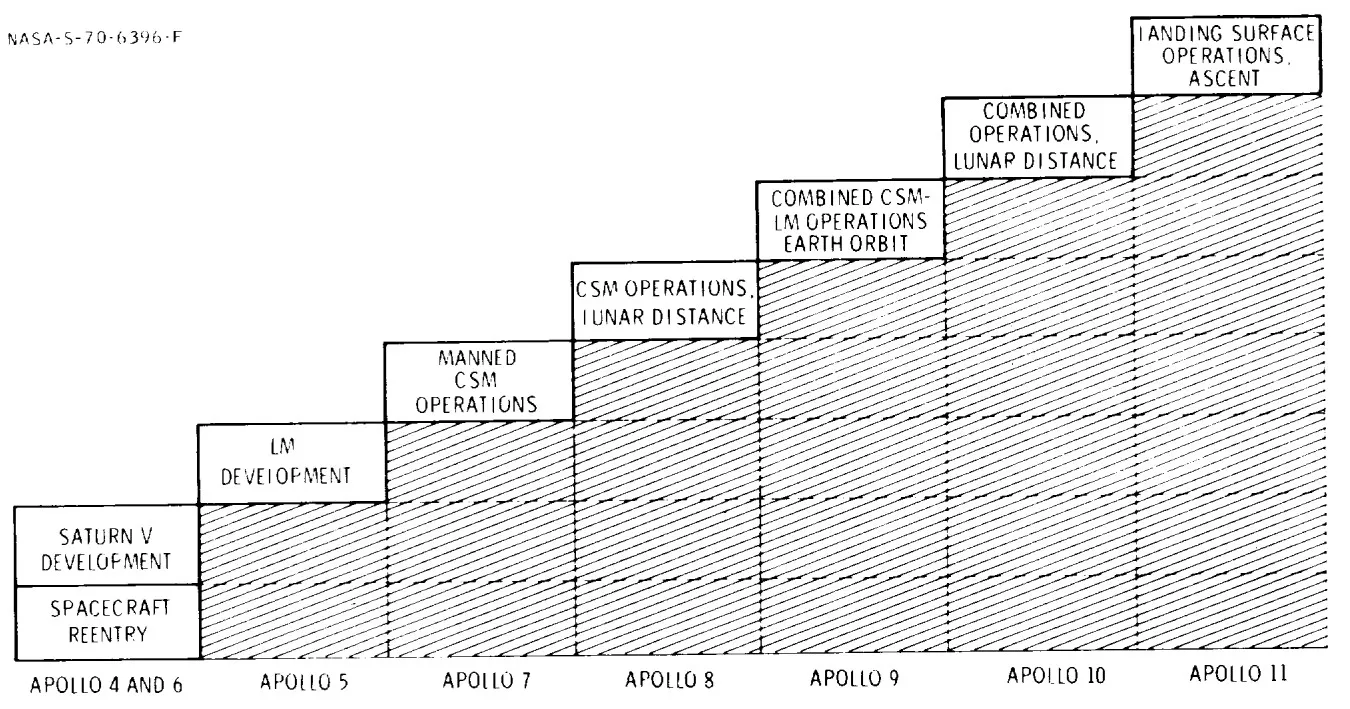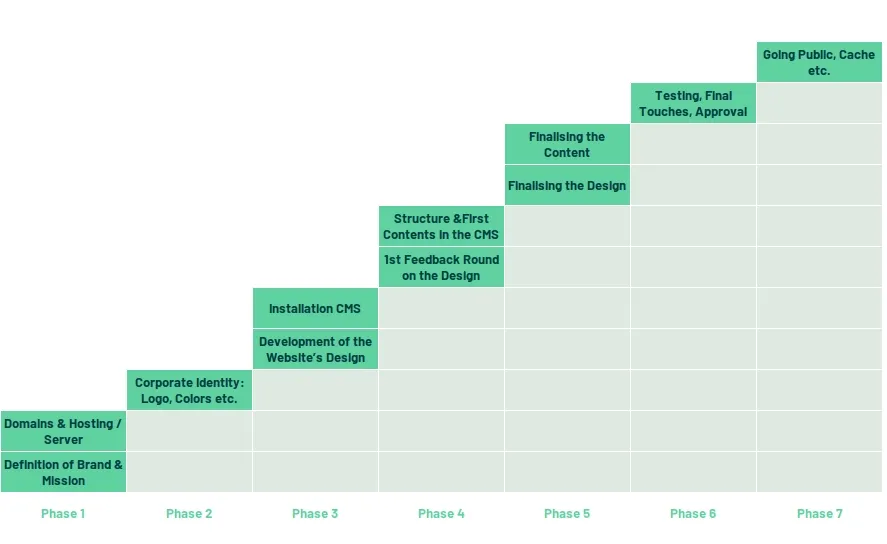What Made Apollo a Success (2/3): The Planning
Author: Peter Schnoor | Reading time: 8 minutes

What Do We Want to Achieve?
At the beginning of every new project, whether large or small, the question of the mission arises: What do we want to achieve? Where do we want to go?
Regarding NASA's ambitious Apollo lunar landing program, the general direction was set by President John F. Kennedy in a speech on September 12, 1962: "We choose to go to the Moon."
This speech followed years of disappointments, during which the Soviet Union achieved one success after another in space, while the USA consistently came in a dishonorable second. Now, the goal was to catch up and land a person on the Moon by the end of the decade. This was to close the technological gap, restore the USA's reputation, conquer space for the "free world," and simultaneously give the US economy a new injection of investment.
Even when I sit down with our clients to discuss the key data of a new project, the fundamental question at the beginning is always: What is our goal? The scope of the project may be smaller than the US space program of the 1960s, but it is important that everyone agrees at the outset on where we are headed. Do we want to improve visibility on the internet? Sharpen the client's brand? Gain ground against the competition? Get more or more suitable applications? Launch a new product?
It may sound trivial, but it is not uncommon for agencies to jump straight into the "how" before clarifying the "where." The "how" always depends crucially on the "where." Without a clear "where," it can happen that many (expensive) activities are developed, but in the end, little is achieved.
Steps to Success
Once the "where" is established and all parties agree, planning can begin. How do we achieve the goal we have set for ourselves in the best possible way? And what does "the best" mean anyway? The most thorough? The fastest? The safest? The most cost-effective?
This can vary from case to case. For NASA, it was clear at the time: The program should be successful by the end of the 1960s, which was an extremely ambitious timeline. Therefore, things had to move quickly. At the same time, the timeline meant that there could not be many setbacks along the way - it had to be planned very carefully. Naturally, as few accidents as possible should occur, because too many human casualties among the astronauts would not only mean the end of the program but could also permanently damage the already tarnished reputation of NASA and the USA. The safety of the astronauts was therefore a very high priority. The costs, on the other hand, had a relatively lower priority in this project.
This can look quite different for other projects. Perhaps costs play a larger role, while the timeline is less critical. Whatever the case may be, it is essential to carefully consider which intermediate steps are necessary to achieve the goal.
The NASA defined these steps in various missions. From Apollo 4-6, in which the lunar rocket Saturn V and the re-entry of the spacecraft were tested and refined (still without crew involvement), they progressed mission by mission until they were ready for the actual lunar landing with Apollo 11. The missions were designed to bring new progress while not overwhelming the crews and ground teams with too many innovations.

A "mission plan" for one of our projects can look quite similar. One step builds on the other, each bringing important innovations and laying the foundation for later developments - until the set goal is finally achieved. This graphic lists the steps that could be planned, for example, for a new website in connection with a revised corporate identity, logo, etc.:

One step builds on the other, ensuring that everything is well defined and tested before expanding functionalities in the next step. It also ensures that everyone involved in the project can immediately see where we currently stand - and what is needed next. Which in turn makes the entire project development transparent and efficient.
The Power of Checklists
Every pilot knows: with complex processes, it is impossible to keep everything in mind. Pilots use clear checklists for all mission-critical procedures, even if they have performed a procedure thousands of times. Because it is precisely then that carelessness and oversight can creep in.
This principle from aviation was adopted at the very beginning of space travel. Checklists have since demonstrably increased safety and consistency in both fields. In the Apollo program, specialists from development, flight planning, and management came together and played out all conceivable scenarios: What if a fuel tank fails? What if two fail? For each of these scenarios - and thousands more - a corresponding checklist and concrete action steps were defined.
One might say: Much effort wasted. Most of the scenarios are known to have never occurred. And yet, the mere fact of being prepared for these possible scenarios has led to missions not having to be aborted, even when unexpected events occurred.
In our industry, checklists are fortunately much less critical for human life than they are in aviation and space missions. And of course, we do not rewrite our checklists for every client. But we work with checklists, and we do so consciously because, despite all our experience, some things can slip through the cracks. By having clear checks for the launch of a website, for example, we can be highly confident that we won't make any major mistakes. The consequences of a careless mistake may be less deadly - but they can certainly be expensive and frustrating for us and our clients.
Flight Management and Mission Control
The question of who should pilot a spacecraft is not as trivial as it seems today. At the beginning of human spaceflight, it was solely the technology that controlled the spacecraft. Yuri Gagarin was still in a capsule where he had practically no control of his own. And even the Americans primarily used automated control, as was common with the warheads of ballistic intercontinental missiles, well into the Mercury program.
Very soon, however, both sides of the Atlantic realized that it could be advantageous - and also serve safety - if the pilot had a greater influence. Thus, the control of the Apollo missions was partly automatic, partly manual, but always monitored and supported by ground control. This system proved particularly effective when the computer systems erroneously reported errors, as was the case during the Apollo 11 lunar landing. During the descent, the computer suddenly displayed an unexpected error. However, the crew under Neil Armstrong was able to quickly assess, override, and continue the descent with the help of the experts in Mission Control.
This interplay between crew and technicians is reflected - on a smaller scale - in our daily interactions between clients and the agency. Modern content management systems allow clients to edit and change their own websites almost at will. And we are happy to give clients this freedom. At the same time, regular backups must be created, and security updates must be implemented. Ideally, we should not have to intervene in any of these cases. But we continuously monitor the progress of automated processes and also gather data on the overall functionality of the website. This way, we can quickly respond to possible outages or errors and effectively support our clients.
I personally see this as one of the great advantages of a professional agency. Anyone can develop a reasonably functioning website these days. However, keeping it secure during ongoing operations and being able to respond quickly to possible errors requires a lot of experience. This experience is based, in our case, on decades of practice in web design and many mistakes we have encountered ourselves and with others, for which we have already developed good responses in advance.
Is All of This Really Necessary?
One question remains: Can't it be done more easily? Such an effort must surely be very expensive?
My answer is: Of course, it can be done more easily. One can develop a website quickly and "by feel." There is no need for checklists or significant intervention in the ongoing operation of a system. But is that good and sustainable? I don't believe so. The effort should be made - but it only needs to be made once. In contrast, websites developed differently often have a very short half-life and soon require an expensive overhaul.
And is it very expensive? No, if done correctly, all of this does not have to be expensive. The Apollo program cost 25.4 billion US dollars, which would be about 150 - 160 billion US dollars today. That was expensive. But it was also entirely new from start to finish: new technologies, new science, new processes, a "giant leap for mankind." This is different in web design today. Checklists and clear processes do not need to be reinvented for every client. And a clear goal definition at the beginning of a project, combined with well-thought-out and practically tested intermediate steps, ultimately saves money.
Big Steps Planned?
What applies to spacecraft also applies to websites: missions need to be well planned, otherwise the damage can be significant.
Contact us and get advice! So that your next step takes you where you want to go.

